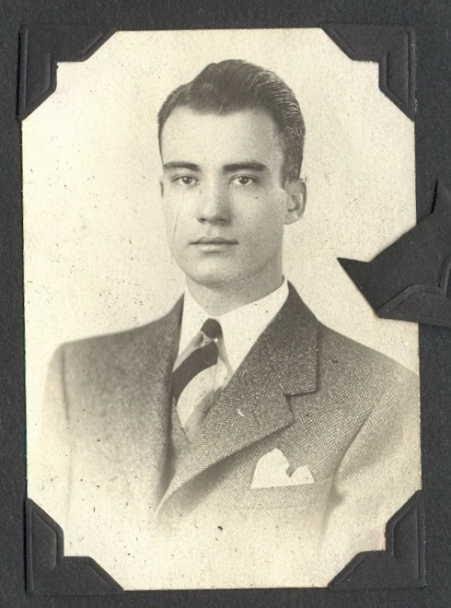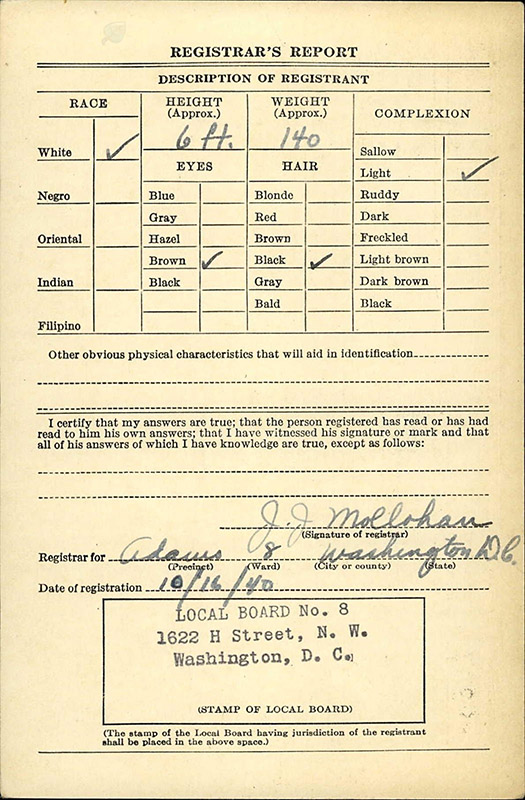Finding Lt. Robert Rogers, Pt 2
Learn the history of Lt. Rogers, a World War II Hero from Decatur and the winding journey the author took to discovery. The story will uncover heroism, classified documents, and family lore. Robert J. Rogers received the Distinguished Service Cross (posthumously) for his heroism in connection with military operations while serving serving as an Officer of a B-24 Heavy Bomber in the 460th Bombardment Group.
Start Here
By G. Michael Pratt, Ph. D.
Part 2: Finding Robert Rogers
…but the interesting part is his story.
By G. Michael Pratt, Ph. D.
I have my own Ancestry account and when I got at home that evening, I just couldn’t let it go. Like 2nd Lt. Rogers, my father, Wade D. Pratt began WWII as a 2nd Lt. and a bomber pilot (in the Eighth Air Force). I couldn’t miss the fact the Lt. Robert Roger’s brother, Flight Officer Lyman L. Rogers, was listed in the “Eight” Air Force any more than I could miss the paper’s misspelling of that unit; but it was the pilot part of Robert Rogers that kept me going.
Anybody, and I mean anybody, who knows me will point out that I perk up and am completely unable to stay out of any conversation related to the “Mighty Eighth” Air Force (or anything Air Force in WWII). My Grandmother saved the many letters that my dad wrote to home from the war. Dad died when I was 16 and Grandma gave me those letters when I was about 25. They are an amazing history of my dad’s experiences in training, combat, and after. His thoughts and feelings about those experiences were written with bravado, but were carefully vague during his 28 combat missions. Then they were written with detail, reflection, and a range of emotions during the six months he was “stuck” in postwar England before his return home in January, 1946. I never knew my dad adult to adult, but I’ve come to know him well in his 20s.
The World War II generation, as we’ve heard, are reticent in talking about their combat experiences. As a teenager, I tried to pin my dad down on details around things I’d heard, but getting real, new information was never easy. Many years later when my step-father (also an Army Air Force veteran) was in his 80s and we’d had a couple martinis; he told me a really horrible story and then broke down. He said “those are the kinds of things people shouldn’t have to know about.” He’d kept it to himself for 60 years.
About 20 years ago someone mentioned their father had flown in WWII but didn’t know much else about it. “Can you get me the number of his bomb group?” I asked. I’ve repeated that question many times and have had success, most of the time, in finding specific information on about 15 WWII flyers. I knew where to look to get more data on 2nd Lt. Rogers; so I did.
I could write out, in order, how I went about researching Robert Rogers and how I figured it out at each stage; but the interesting part is his story.
Robert Jackson Rogers, Jr., was born in Decatur, November 5, 1917, to Robert, Sr., a salesman for a wholesale grocery and his wife Zula (Bottenfield) Rogers. The family was likely renting a place on Covington Avenue when Robert, Jr., was born and they certainly lived there in 1920. He was the first of five children. By 1930 when Robert was 12, he and his four younger siblings lived at 226 South McDonough Street. His father now worked as a salesman in a feed store and the family rented their house near Agnes Scott College for $40 a month. Robert, Jr., graduated from Decatur Boy’s High School, a three-year high school that appears to have had a strong military and R.O.T.C. component. I didn’t find him in the online copies of the 1933 or 1940 yearbooks. The school list says he graduated in 1935 1. The 1940 U. S. Census listed the Rogers family as renters at 204 South McDonough Street 2 for $35 a month. They had lived there since at least 1935. Robert, Jr., who was living at home, had completed two years of college at Atlanta Law School (a private, night school) and was a full-time cashier in the packing industry making $1,020 in 1939. His father was working full time in the wholesale grocery business and made $1,100 in 1939. And his 20 year-old sister, Jane, was a full-time file clerk for the insurance industry making $780 in 1939. The 1940 Atlanta City Directory (which includes Decatur) gives Robert, Jr.,’s work as a bookkeeper for Goodyear Services Stores in Atlanta, lists Robert, Sr., as a dairyman, and lists Jane as a stenographer for Maryland Casualty Company in Atlanta 3. It is likely that the federal job classifications used by the Census takers prevented more detailed information from being recorded.

Robert Jackson Rogers, Jr., probably 1935-1940 4
Between the 1940 census in April, and his registration for the Draft on October 16, 1940, Robert Rogers, Jr., moved from Georgia to a job with the U. S. Department of Commerce, Bureau of Census at 2nd and D Streets, SW, Washington D.C. He lived at 1901 Biltmore St., NW, Washington D. C. (The first draft registration under the 1940 Selective Training and Service Act required all males ages 21-36 to register on October 16, 1940. Those registrants would be in the first draft for what would become U. S. participation in WW II.) 5

D.S.S. Form 1, Selective Training and Service Act of 1940 for Robert Jackson Rogers, Jr. 6

December 7, 1941, changed everything for almost everyone in the United States. We have no information on how Robert in Washington D. C. or his family in Decatur learned of the attack on Pearl Harbor, but it undoubtedly came as a shock. Rogers enlisted in the Army Air Corps in 1941, probably shortly after Pearl Harbor. He would have followed a path through various basic training and classification bases to qualify for pilot training. Then he would have gone through primary, basic, and advanced flight training programs resulting in being commissioned as a United States Army Officer and qualified as an Army (multi-engine) Pilot, winning his “wings” and his silver bar (2nd Lieutenant) rank at the same time 7. His commissioning was at William’s Field, Mesa, Arizona, sometime in 1943. His next step was “transition”, to learn to pilot the four-engine Heavy Bombers: the Boeing B-17 “Flying Fortress” or the Consolidated B-24 “Liberator.”

Rogers trained on the Consolidated B-24, an aircraft just over 64 feet in length and with a 110 foot wingspan. Fully loaded with 5,000 pounds of bombs (usually 10-500 lb. or 5-1000 lb. bombs) and 2,364 gallons of aviation gasoline, the B-24 weighed 61,500 pounds. At an altitude of 20,000 feet, its maximum speed was 227 miles per hour. Once he mastered the giant B-24, Rogers was assigned to the newly created 460th Bomb Group. The 460th Bomb Group began forming its headquarters component in August, 1943, and eventually trained as a unit at Chatham Army Air Field, Savannah, Georgia in late 1943. 9
During this time Rogers met the other nine men who would form his crew and build themselves into a close-knit team. A new B-24 crew had four officers (usually all 2nd Lieutenants) and six enlisted men (usually Staff or Technical Sergeants). All were officers or non-commissioned officers to get them better treatment if captured by the enemy. The officer positions were: Pilot – Aircraft and crew commander; Co-Pilot – second in command, relief pilot and responsible for specific cockpit duties; Navigator – responsible for getting the aircraft to the target and back; and the Bombardier – responsible for operating bombsights, understanding and identifying the target, and aiming the bombs. Five of the enlisted men were primarily defensive gunners 10, but each had other duties associated with aircraft operations. The sixth enlisted man was the aircraft radio operator, who was responsible for the interphone, communications with other aircraft or the airfield, and operating radio-location and direction-finding instruments. If needed, the radio operator served as a second waist gunner.
The B-24 H had electrically powered nose, top, ball (ventral) and tail turrets, each armed with two .50 caliber machine guns; and two single .50 caliber machine guns in the waist, usually manned by a single gunner. Lt. Rogers and his crew practiced formation flying, bombing, aerial gunnery, and emergency procedures while at Chatham and by the end of 1943, the 460th was prepared to enter combat.It is likely that Lt. Robert Rogers received leave and was able to travel to Decatur to visit his family before “shipping out.” He could not tell his family (and probably did not know) where he would be stationed. It was the last time they would meet.
End of Part 2
- U. S. Census, Decatur District, DeKalb County, Georgia for Robert Rogers, January 29, 1920; U. S. Census, Decatur Borough (Part), DeKalb County, Georgia for Robert Rogers, April 9, 1930; U. S. School Yearbooks, 1900-1999, Decatur, Georgia Boys High School, 1933 and 1940. (Ancestry.com); https://patch.com/georgia/decatur/dhs-close-up-club-students-need-info-on-wwii-soldiers
- 226 and 204 South McDonough St. are now part of the Agnes Scott College campus. Both houses are gone.
- U. S. Census, Decatur City, DeKalb County, Georgia for Robert Rogers, April 2, 1940.
- Photo of Robert Rogers. (Collins, Rogers Family Tree, Public Trees, Ancestry.com)
- Information on the Selective Service Act of 1940 (Fold3.com) https://www.fold3.com/title/816/wwii-draft-registration-cards#:~:text)
- U. S. WWII Draft Cards Young Men, 1940-1947 for Robert Jackson Rogers, Jr. (Ancestry. com: Images 1793 & 1794)
- Aviation Cadet Training https://en.wikipedia.org/wiki/Aviation_Cadet_Training_Program_(USAAF)
- B-24 H Cross section. http://freepages.rootsweb.com/~webermd1/family/Cutaway-3-web.jpg
- History of the 460th Bomb Group, 460th Bombardment web site. http://www.15thaf.org/55th_BW/460th_BG/History/History.html
- Consolidated B-24 Liberator https://en.wikipedia.org/wiki/Consolidated_B-24_Liberator




